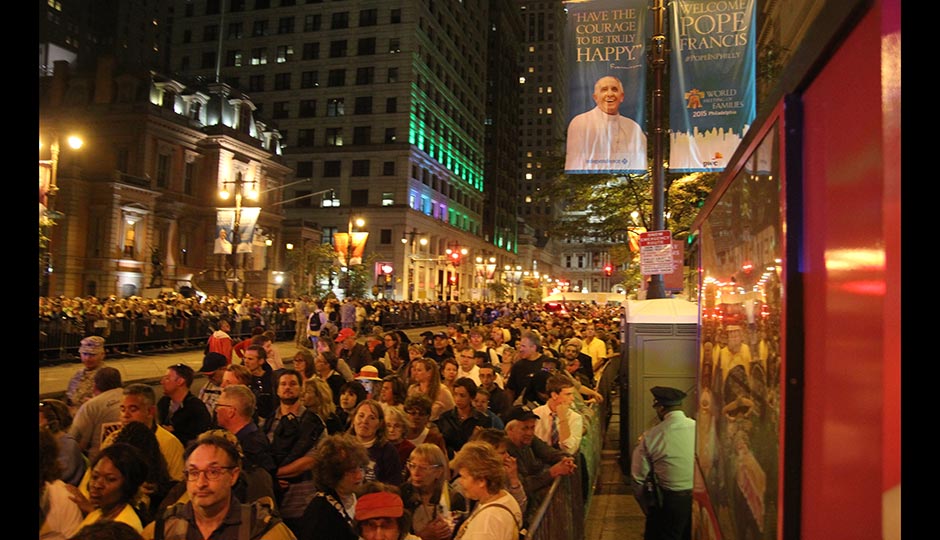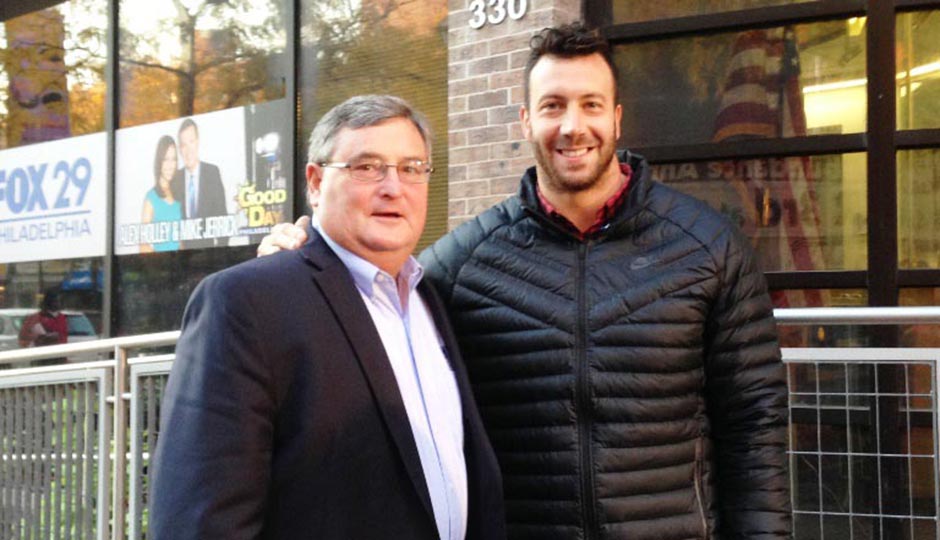The Five Biggest Philadelphia Transportation Stories of 2015
If anything, 2015 was the Year of the Bike on the transportation front locally, with major new facilities opening up the promise of faster, easier bike commuting, adding steam to a steady climb in practical bike use. And one major event that promised to disrupt lives all over the city instead opened everyone’s eyes to the potential contained in car-free streets (done right this time; no one’s interested in bringing the Chestnut Street Transitway back from the dead). But the biggest transportation story of the year is the one that’s still not over yet. Herewith, my picks for Top Philadelphia Transportation Developments of 2015:
5. Pushing the Reset Button on the Boulevard
Roosevelt Boulevard, the Highway from Hell, dates to 1911, when it was called the Northeast Boulevard or Bensalem Boulevard, depending on where you were. But the highway as we know it now is a creature of the 1950s. Neither expressway nor parkway, it invites motorists to treat it like the former while the rest of us take our lives in our hands trying to cross it and slog up it in buses that take forever to get from one end to the other.
This May, armed with a Federal TIGER grant, the city launched a long-term study that aims to rethink the Boulevard from curb to curb with the aim of making it a street everyone can use: drivers, transit riders, bicyclists and pedestrians alike. The study seeks to come up with changes to the street that can be made both right away and incrementally over time to turn it into what Mayor’s Office of Transportation and Utilities chief Denise Goren called “the best complete street in America.”
There’s certainly enough room to do that in the Boulevard’s expansive footprint, and while it’s likely that MOTU as we know it will not survive into a Kenney administration, we trust that the Boulevard study will continue apace and produce many beneficial changes. Maybe, even one day in the distant future, we’ll get that subway everybody wants now but the city can’t afford.

Waiting at Broad Street. Photo | SEPTA
4. The Papal Visit
Like so many other stories about transportation hereabouts, this one began with dire warnings of calamity: With all the traffic restrictions and security zones, no one would be able to get anywhere over the weekend of Pope Francis’ visit. While the security zones did make it all but impossible to get from South Philly to North Philly via Center City and vice versa, just about every other aspect of transportation that weekend turned out better than anyone had feared.
Center City residents exulted in having the streets all to themselves and took to them on foot, skateboards, bikes, you name it, contributing to the festival atmosphere within the secure perimeter. The experience even got some to thinking what it might be like to make this a permanent state on some streets, or at least a recurring event.
Meanwhile, a combination of good advance planning, good communication (including plenty of customer service staff) and a smaller-than-anticipated advance sale of Papal Visit passes (not to mention use of those sold) resulted in SEPTA getting everyone who came from further out to and from Sunday’s Papal Mass with minimal fuss and no service meltdowns.

Joe Casey (left) and Connor Barwin. Photo | Septa.org.
3. Changing of the Guard at SEPTA
The nearly seamless leadership transition from retired SEPTA General Manager Joe Casey to successor Jeff Knueppel illustrates just how far the mass transit agency we all hate to love has come under Casey’s tenure.
There was a time when a SEPTA general manager’s departure would have triggered a nationwide search for a successor who was likely to enjoy (if that’s the right word) the (lack of) support of a divided SEPTA Board and perpetual funding crises. The road back from that precipice began under Casey’s predecessor Faye Moore, the first African-American woman to head a major transit system and the first in nearly two decades to be promoted to the top job from within (she had been SEPTA’s treasurer and had earned the SEPTA Board’s confidence for balancing the agency’s budget for four years in a row).
Casey picked up where Moore left off, only to have to deal with another serious budget crisis when the state’s transportation funding mechanism foundered when the Federal government refused to allow tolls on I-80. To his credit, Casey responded by maintaining service while slashing the maintenance budget and launching a masterful (and successful) campaign to win public support for a fix to the funding mess. Meanwhile, he continued Moore’s focus on improving the customer experience and managed to keep the system in running order on inadequate capital funds. For all this, he and his agency were rewarded with an American Public Transportation Association award in 2012 as Best Large Transit System.
Knueppel’s elevation to GM makes it three internal promotions in a row at SEPTA, a testament to the deep bench of talent the agency has developed. Still think SEPTA stinks? I’ll buy you a SmarTrip card and you can go take your chances on the Washington Metro. (But see No. 1 below.)

Photo via the Bicycle Coalition of Greater Philadelphia/Facebook
2. Trails to the Future, Across the Schuylkill and Along the Delaware
It’s long been a goal of the city’s bicycle advocates to return bikes to their onetime role as practical transportation. As they are in the Netherlands still, bikes were once the individual transport mode of choice for millions before the infernal, er, internal combustion engine changed everything. While it’s not likely that bikes will ever become as widespread on the American road as they were at the end of the 19th century, bike use on the whole in Philadelphia is climbing rapidly, and commuting by bike even faster still.
Which makes the ongoing campaign to “Connect the Circuit” — a projected 750-mile network of bicycle and pedestrian paths linking both recreational facilities and employment centers all over the Greater Philadelphia region, perhaps the most ambitious and extensive bicycle infrastructure project in the country — worth keeping tabs on. This year saw the addition of several major links in that chain, none more significant than the conversion of the Manayunk Bridge over the Schuylkill from railroad to trail use. The completion of this project in October wrapped up a successful effort that got two municipalities, two counties, the Commonwealth of Pennsylvania, SEPTA and community activists on both banks of the river to turn a crumbling landmark into the linchpin of a new bike commuting route. (Now all that needs to happen to fully realize the vision is to find the money to put lights on it.)
Meanwhile, over on the other river, the East Coast Greenway, an Appalachian Trail for bike users, got a little bit longer with the addition of a new segment of the Delaware River Trail in the city’s Port Richmond section last month. That project also extended Delaware Avenue northward from its current end, opening up long-abandoned industrial land and onetime rail yards for redevelopment. Work also began on “Bartram’s Mile,” a key section of the Schuylkill River trail in Southwest Philadelphia that will take the trail and the Greenway down the river’s west bank via a former railroad bridge being converted to bike use.
1. SEPTA Key: Coming in … ?
We know, we know. SEPTA’s new fare payment technology will be truly revolutionary: a contactless system that will work with any payment card you choose on any transit mode SEPTA operates, making it easier to purchase fares and pay for your rides no matter where you’re headed or how you’re getting there — something no other electronic fare payment system now in use offers.
Signs of things to come are now on every SEPTA bus and in every subway and elevated station. It’s going to be wonderful when it goes live. Trouble is, it was supposed to have gone live sometime this year. Or at least that’s what SEPTA spokespeople were saying last year at this time, when the vending machines, reader screens and new turnstiles first began to appear.
The weird noises you hear emanating from those turnstiles indicate that testing is indeed taking place at least, but the line from 1234 Market is now, and has been for some time, that the SEPTA Key team wants to make sure every aspect of the technology operates flawlessly before rolling it out to the riding public as a whole. When might that happen? According to a SEPTA spokesperson, we should see the first public rollout of SEPTA Key cards sometime around the end of the first quarter of 2016. (They’re probably making odds on this in Vegas right now.) But while it may be cold comfort to all of us who are still waiting for the Promised Land, it may well be that we’re waiting so long because SEPTA was heading into uncharted territory with no good guides for the trek. And again, other transit agencies are experiencing the same teething pains as they try to bring their existing fare-payment technology into the 21st century. At least we’ll still get there first.
Follow @SandySmith on Twitter.


